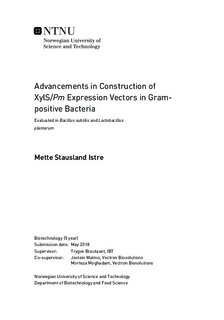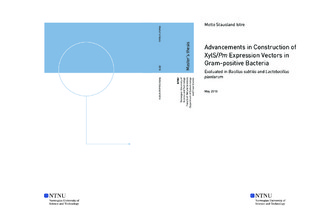| dc.description.abstract | Escherichia coli (E. coli) is the most commonly used host for expression of recombinant proteins. A large fraction of recombinant proteins produced in E. coli are stored in an insoluble form, making them inaccessible for therapeutic use. Moving production into a Gram-positive host, could increase the availability. Many Gram-positive species can secrete proteins into the growth medium, and have a different intercellular environment potentially allowing for soluble protein expression in cases where E. coli falls short. The aim of this thesis was to make further advances in the adaption of the XylS/Pm expression cassette for production of recombinant proteins in Gram-positive bacteria, such as Bacillus subtilis (B.subtilis) and Lactobacillus plantarum (L. plantarum). Due to time constraints, little work was completed for L. plantarum.
In total 12 B. subtilis/E. coli shuttle vectors harboring the XylS/Pm cassette were constructed. Six plasmids contained a codon-optimized xylS, while the remaining six had xylS replaced by the codon-optimized xylS-GFP. The constructed vectors, pMSI58-69, were successfully transformed into both E. coli and B. subtilis. Following induction of m-toluate, only one construct was found functional in E. coli producing measurable mCherry levels. None of the vectors had mCherry production in B. subtilis. Fluorescence from the XylS-GFP fusion protein was not observed in either species.
Further investigations into the low mCherry production, led to attempts of identifying possible bottlenecks at the XylS or mCherry levels of expression. It was desirable to determine if transcription of these two proteins were obstructed. XylS levels were evaluated for all 12 constructs in B. subtilis. Only constructs with the medium promoter, Pmet had considerable XylS production. The constructs with the weak and strong promoters, PliaG and P43 respectively, showed little or no XylS production. XylS expression for the constructs with Pmet in E. coli was evaluated and compared to B. subtilis. Both hosts appeared to have similar expression levels in both soluble and insoluble fractions.
Expression levels of XylS for the most promising pMSI-plasmid, pMSI66, was compared to the expression levels of pSH3. pSH3 had mCherry expression in E.coli, although none was observed in B. subtilis. Comparison in B. subtilis was not possible due to problems with lysis of the pSH3 harboring cells. The comparison pMSI66 in B. subtilis and pSH3 in E.coli revealed similar levels of XylS expression. Exchanging the original promoters controlling XylS production in the XylS/Pm cassettehas lead to a solution for the reported bottleneck in XylS production. A new bottleneck has been identified in its stead, expression from the Pm promoter. This work is a contribution to the ongoing research in developing B. subtilis as an alternative bacterial host to the much used E. coli. | |

